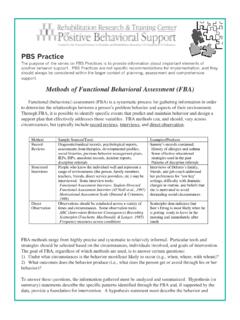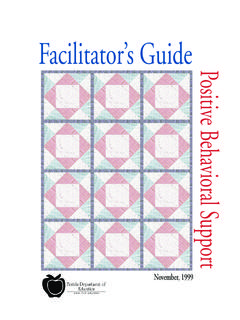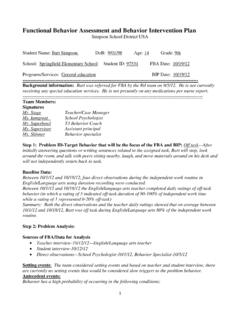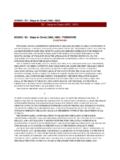Transcription of 1 Running head: POSITIVE BEHAVIOR SUPPORT Positive ...
1 POSITIVE BEHAVIOR SUPPORT 1. Running head: POSITIVE BEHAVIOR SUPPORT . POSITIVE BEHAVIOR SUPPORT : Evolution of an Applied Science Edward G. Carr State University of New York at Stony Brook and Developmental Disabilities Institute Glen Dunlap University of South Florida Robert H. Horner University of Oregon Robert L. Koegel University of California at Santa Barbara Ann P. Turnbull and Wayne Sailor University of Kansas Jacki Anderson California State University, Hayward Richard W. Albin University of Oregon Lynn K. Koegel University of California at Santa Barbara Lise Fox University of South Florida POSITIVE BEHAVIOR SUPPORT 2. Abstract POSITIVE BEHAVIOR SUPPORT (PBS) is an applied science that uses educational and systems change methods (environmental redesign) to enhance quality of life and minimize problem BEHAVIOR . PBS initially evolved within the field of developmental disabilities and emerged from three major sources: applied BEHAVIOR analysis, the normalization/inclusion movement, and person-centered values.
2 Although elements of PBS can be found in other approaches, its uniqueness lies in the fact that it integrates these nine critical features into a cohesive whole: comprehensive lifestyle change, a lifespan perspective, ecological validity, stakeholder participation, social validity, systems change/multicomponent intervention, emphasis on prevention, flexibility in scientific practices, and multiple theoretical perspectives. These characteristics are likely to produce future evolution of PBS with respect to assessment practices, intervention strategies, training, and extension to new populations. The approach reflects a more general trend in the social sciences and education away from pathology-based models to a new POSITIVE model that stresses personal competence and environmental integrity. POSITIVE BEHAVIOR SUPPORT 3. POSITIVE BEHAVIOR SUPPORT : Evolution of an Applied Science The fourfold purpose of this paper is to: (a) provide a definition of the evolving applied science of POSITIVE BEHAVIOR SUPPORT (PBS); (b) describe the background sources from which POSITIVE BEHAVIOR SUPPORT has emerged; (c) overview the critical features that, collectively, differentiate POSITIVE BEHAVIOR SUPPORT from other approaches; and (d).
3 Articulate a vision for the future of PBS as a field. Definition We recently completed two syntheses of the field from which it is clear that PBS. is an applied science that uses educational methods to expand an individual's BEHAVIOR repertoire, and systems change methods to redesign an individual's living environment to achieve first, an enhanced quality of life and, secondarily, to minimize problem BEHAVIOR (Carr, Horner et al., 1999; Koegel, Koegel, & Dunlap, 1996). By POSITIVE BEHAVIOR , we mean all those skills that increase the likelihood of success and personal satisfaction in normative academic, work, social, recreational, community, and family settings. By SUPPORT , we mean all those educational methods that can be used to teach, strengthen, and expand POSITIVE BEHAVIOR , and all those systems change methods that can be used to increase opportunities for the display of POSITIVE BEHAVIOR . The primary goal of PBS is to assist an individual's lifestyle to evolve in a direction that enables all relevant stakeholders ( , teachers, employers, parents, friends, and the target person himself/herself) to have the opportunity to perceive and to enjoy an improved quality of life for themselves.
4 An important, but secondary, goal of PBS is to render problem BEHAVIOR irrelevant, inefficient, and ineffective by helping an individual to achieve his/her goals in a socially acceptable manner, thus reducing or eliminating altogether, episodes of problem BEHAVIOR . Background Sources Related to Philosophy and Practice PBS emerged from three major sources: (a) applied BEHAVIOR analysis, (b) the normalization/inclusion movement, and (c) person-centered values. Applied BEHAVIOR Analysis Applied BEHAVIOR analysis is the systematic extension of the principles of operant psychology to problems and issues of social importance (Baer, Wolf, & Risley, 1968). Were it not for the past 35 years of research in applied BEHAVIOR analysis, PBS could not have come into existence. Applied BEHAVIOR analysis has made two major contributions to PBS. First, it has provided one element of a conceptual framework relevant to BEHAVIOR change. Of second and equal importance, it has provided a number of assessment and intervention strategies.
5 With respect to concepts, PBS is indebted to applied BEHAVIOR analysis for the notion of the three-term contingency (stimulus-response-reinforcing consequence), the concepts of setting event and establishing operations, and the notions of stimulus control, generalization, and maintenance (Chance, 1998; Miltenberger, 1997). These and other POSITIVE BEHAVIOR SUPPORT 4. concepts have served as a critical springboard for the elaboration and development of PBS as a field. With respect to assessment strategies, applied BEHAVIOR analysis originated the notion of functional analysis, an experimental method for determining the motivation (purpose) of a variety of socially significant behaviors, thereby facilitating intervention planning designed to change BEHAVIOR in a desirable direction (Carr, 1977; Iwata, Dorsey, Slifer, Bauman, & Richmond, 1982). The detailed elaboration of empirical methodologies, emphasizing the ongoing, direct measurement of BEHAVIOR , has been and continues to be one of the enduring contributions of applied BEHAVIOR analysis.
6 With respect to intervention strategies, applied BEHAVIOR analysis helped develop educational methods such as shaping, fading, chaining, prompting, and reinforcement contingencies as well as a wide array of procedures for reducing problem BEHAVIOR (Sulzer-Azaroff & Mayer, 1991). It is also true, however, that PBS has not only incorporated the elements of applied BEHAVIOR analysis just described but has also evolved beyond the parent discipline to assume its own identity. This identity is strongly influenced by the realities of conducting research and intervention in natural community settings that necessitate changes in assessment methods, intervention strategies, and the definition of what constitutes a successful outcome (Carr, 1997). These themes are an important focus of the present paper. Normalization/Inclusion Movement Philosophically, PBS subscribes to the principle and ideal of normalization, namely, that people with disabilities should live in the same settings as others and have access to the same types of opportunities as others (in terms of home, school, work, recreation, and social life).
7 The principle of normalization rests, most critically, on the idea of social role valorization, namely, that the ultimate goal is to ensure that people who are in danger of being devalued are helped to assume valued social roles thereby greatly increasing the likelihood that they will be accorded respect from others as well as receiving an equitable share of existing resources (Wolfensberger, 1983). The normalization principle leads naturally to the principle of inclusion. Over the past 150 years, American social history has been characterized by an ever-increasing emphasis on individual rights being extended to formally disenfranchised groups thereby facilitating the inclusion of those groups into the mainstream of society. The upward inclusion trajectory began with the women's rights/women's suffrage movement (1848- 1920) (Buechler, 1990), continued with the civil rights movement of the late 1950's and early 1960's (Solomon, 1989) and, has most recently focused on the movement emphasizing the rights of individuals with disabilities that evolved during the 1970's and 1980's (Gilhool, 1989).
8 The inclusion movement for people with disabilities continues to this day. In the educational arena, it embodies the trend towards placing students with disabilities in general education classrooms (Bricker, 1995) as opposed to segregated, special education facilities and, most significantly, changing systems so that specialized school SUPPORT becomes fully integrated and coordinated with the general education program in neighborhood schools (Sailor, 1996). Importantly, inclusion in normalized settings extends beyond education. For example, in the vocational sphere, it involves replacing sheltered workshops with supported employment. Inclusion also involves replacing group homes and other congregate facilities with supported living arrangements POSITIVE BEHAVIOR SUPPORT 5. (in which one chooses one's housemates and the neighborhood in which one wishes to live), and replacing artificial social and recreational opportunities ( , social groups for people with disabilities) with those emphasizing participation with people who may not have disabilities ( , membership in religious groups, community gyms, social and ethnic clubs).
9 Person-Centered Values The PBS philosophy embraces the idea that while humanistic values should not replace empiricism, these values should inform empiricism. Science tells us how we can change things, but values tell us what is worth changing (Carr, 1996). Guided by this precept, PBS represents a melding of values and technology in that strategies are judged not only with respect to efficacy (a technological criterion) but also with respect to their ability to enhance personal dignity and opportunities for choice (a values criterion). Thus, the approach eschews the use of strategies that members of the community judge to be dehumanizing or degrading (Horner et al., 1990). Three interrelated processes serve as the vehicle for implementing the values perspective just described: person-centered planning, self-determination, and the wraparound approach. Person-centered planning (Kincaid, 1996; O'Brien, Mount, & O'Brien, 1991;. Smull & Harrison, 1992; Vandercook, York, & Forest, 1989) is a process for identifying goals and implementing intervention plans that stands in sharp contrast to traditional program-centered planning.
10 In program-centered planning, individuals with disabilities are provided with those pre-existing services that a particular agency or institution has available. In person-centered planning, the specific needs and goals of the individual drive the creation of new service matrices that are carefully tailored to address the unique characteristics of the individual. Specific individual needs are considered within the context of the normalization and inclusion values perspectives, alluded to earlier, to produce an intervention plan that emphasizes community participation, meaningful social relationships, enhancing opportunities to make choices, creating roles for the person that engender respect from others, and continued development of personal competencies. Because person-centered planning seeks to empower individuals with disabilities, it almost invariably leads to a focus on the issue of self-determination. Self- determination is a multidimensional construct that includes but is not limited to process elements involving choice and decision making, problem solving, personal goal setting, self-management, self-instruction, and self-advocacy (Wehmeyer, 1999; Wehmeyer, Kelchner, & Richards, 1996).













